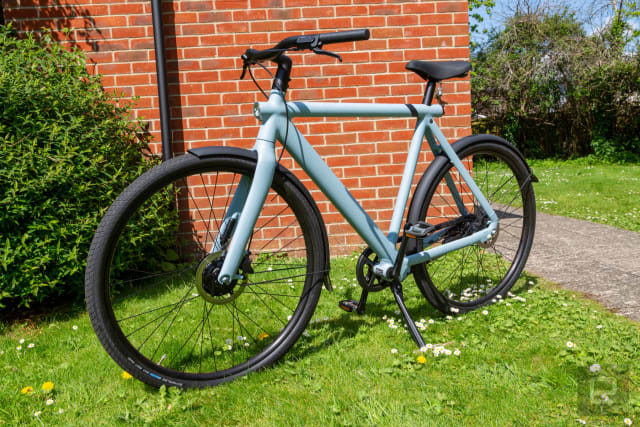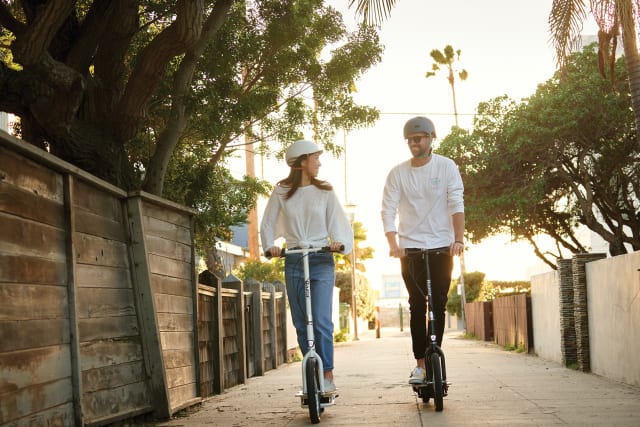People were buying electric bikes and scooters long before the pandemic. Some saw them as a cheap and reliable way to reach the office. Others wanted a vehicle that could take them to the nearest park, supermarket or brunch-time meet-up. The coronavirus outbreak has been a catalyst for the industry, though. At first, when so many countries were imposing strict lockdowns, people wanted a way to safely exercise outdoors. Then, as these restrictions began to ease, citizens sought new ways to move around — for work, pleasure, or completing errands — that would minimize their contact with other people. For many, the obvious answer was a small electric vehicle.
Back in April, bicycle specialist Shimano asked 13,000 Europeans whether they were more likely to buy, rent or generally use an electric bicycle compared to 12 months ago. Five percent said they were “very likely,” while 12 percent said they were “likely” and eight percent reported that they already own or use an e-bike. In a State of the Nation report, Shimano combined these numbers and concluded that one in four Europeans either ride or are likely to use an electric bicycle this year. The people who responded positively said they were most interested in using an e-bike for leisure and family cycling. Commuting came second, followed by fitness and carrying heavy loads, such as groceries and small children.
Many e-bike manufacturers have converted that interest into sales. VanMoof, a Dutch startup often described as the Tesla of bicycles, more than doubled its orders year-over-year between January and October 2020. The growth was undoubtedly helped by its third-generation e-bikes, the S3 and X3, which launched on April 21st. The company took 4,400 orders in the 24 hours that followed, a spokesperson told Engadget. They were part of a four-month sales window that trumped the previous two years combined.

That growth is particularly impressive given the company’s decision to slim its portfolio this year. VanMoof had offered versions of its S2 and X2 bikes without a battery (hence why the motorized versions were branded Electrified S2 and X2) but abandoned this ‘smart bike’ concept with the S3 and X3 reveal.
Cowboy, another upstart brand with a focus on technology, has experienced similar growth. Sales of its stylish commuter e-bike, which hides the battery behind the seat post, were 140 percent higher than the previous year. A spokesperson told Engadget that sales rose by 40 percent between March and April, just when many countries in Europe were imposing strict lockdown measures.
Cowboy bikes have a GPS module embedded in the frame, so the company was also able to track how rider behavior changed throughout the year. Unsurprisingly, many cyclists stopped riding during the traditional commuter period. They cycled less frequently, Cowboy noted, but their average distance went up — a sign that most were riding for pleasure, rather than transportation.
The growth hasn’t been limited to tech-focused startups, though. Rad Power Bikes has flourished as a manufacturer of cheap but reliable two-wheelers. “We’ve experienced exponential growth every year since 2015, and expected to have another record-breaking year as we headed into 2020, but the new level of demand we’ve seen throughout this year has been unprecedented,” the company said in a statement. Like Cowboy, the company saw explosive growth in the spring, when the pandemic was surging through Europe and the US. Sales in April were up 297 percent year-over-year, “and we haven’t seen any signs of demand slowing down since then,” a spokesperson told Engadget.
“The new level of demand we’ve seen throughout this year has been unprecedented.”
At the other end of the e-bike spectrum is Riese & Müller. The German manufacturer is renowned for building expensive but high-quality and long-lasting e-bikes. Unlike VanMoof, Cowboy and Rad Power, the company has embraced Bosch’s highly regarded motors, which are located near the pedals rather than the front or back hub. The company ramped up production from 56,000 to 70,000 bicycles during the 2019/2020 financial year. Orders slowed down as stores closed in the spring, a spokesperson told Engadget. But that “temporary decline” soon reversed.
“In large cities like Berlin or London, pop-up bike lanes were created to show what a bicycle-friendly infrastructure can look like and how it influences the flow of traffic in cities,” Dr Sandra Wolf, CEO of Riese & Müller told Engadget. “Sales figures reflect these changes, but also the general transition towards more sustainable mobility solutions that we have seen in recent years.”
Moustache, a French manufacturer with e-bikes named after days in the week (Lundi, Samedi, Dimanche, etc.) has increased manufacturing, too. The company will produce 65,000 ‘Season 10’ models — which are expected to be sold between September 2020 and August 2021 — up from the 42,000 it built for Season 9. “The e-bike is steadily growing in all markets and Moustache is continuing to progress very rapidly,” Clément Bonneau, Moustache’s head of global PR and marketing told Engadget.
The COVID-19 sales boom also extends to British brands. Sales of Brompton’s electric bike, for example, have grown 40 percent year-over-year. Gocycle sales, meanwhile, have grown by half this year. The latter could have been even higher, a spokesperson told Engadget, if the company had more stock. “We’ll look back and see this as the moment that e-bikes were propelled into the mainstream,” Gocycle founder and designer Richard Thorpe said. “Covid has pulled the e-bike adoption curve forward with more people switching onto their enormous health and lifestyle benefits.”
Volt, another British e-bike brand, experienced a 300 percent year-over-year increase at the height of lockdown. It also completed a manufacturing hub in Milton Keynes, England, that will produce up to 25,000 bikes every year. “We faced-up to the daunting challenge of adapting facilities and processes to ensure that we keep our people and customers safe, whilst realizing our dream of delivering a cutting-edge e-bike factory,” a spokesperson said.
Gazelle, a Netherlands-based company founded in 1892, is making inroads in the US, too. The company has seen “increased retail distribution” and “double-digit growth” for its wares, a spokesperson explained, which includes both traditional and electric bicycles.

The situation has been a little different for electric scooters. While it’s possible to buy one outright — many companies have found success with this model, including Xiaomi and Segway-Ninebot — many access them through ride-hailing services. Some companies including Lime haven’t seen a rise in ridership this year. “Two of the primary reasons people use scooters are effectively nonexistent,” a spokesperson told Engadget, referring to commuting and tourism. Lime’s business has slowly recovered, though, as lockdown restrictions have eased. Riders are using scooters again for short journeys — grabbing groceries at their nearest bodega, for instance — or a brief escape from their home.
According to Bird, more people are trying its rental scooters as a safe alternative to chauffeur-driven Ubers and Lyfts. The share of trips taken by first-time users doubled in North America, a spokesperson explained, following the outbreak. Even now, a third of all trips in the region are taken by people who have never hired a Bird scooter before. That doesn’t mean that overall rentals have grown, necessarily, but it shows a broader acceptance of the general concept.
Bird’s business extends beyond rentals, though. The company launched the Bird Air last September, a $599 electric scooter designed to compete with other mid-priced offerings from Xiaomi, Segway Ninebot and Razor. Bird hasn’t disclosed any sales figures for its scooter range, which also includes the Bird One and kid-friendly Birdie. Clearly, though, the company sees interest or potential in the direct-to-consumer model, otherwise it wouldn’t have launched the Air at all.
Rental scooters were a mess when they first arrived in the US. People complained about the sheer volume that was broken, ridden dangerously, or left to clog up the sidewalks. Regulators recognized the problem and have since introduced permit schemes that mitigate some of the problems. All of that work has given other countries confidence in the concept. The UK, for instance, announced in June that shareable scooters would be allowed the following month. It wasn’t a free-for-all, though — companies still needed permission to operate, and riders needed a full or provisional car, motorcycle or moped license. The UK isn’t awash with schemes, but early approvals have increased the nation’s access and acceptance of the technology.
Razor’s sales have increased 81 percent year-over-year.
The ongoing pandemic has helped the direct-to-consumer scooter market, too. Razor’s sales, for instance, have increased 81 percent year-over-year — and that’s excluding the typically busy holiday season. That figure includes the company’s traditional kick scooters, but undoubtedly covers some electric variants too like the EcoSmart SUP, E300 HD and C25, all of which were announced in July.

Everyone hopes that the world will return to some form of ‘normal’ soon. Effective vaccines are slowly rolling out, promising some degree of resistance — and by extension, freedom — for those who take them. It could be a while, however, before the global population has access to such a treatment. In the meantime, people will need to contemplate and, where possible, minimize actions that could increase coronavirus cases. Electric bikes and scooters, therefore, could remain a vital tool while the world continues to grapple with the virus.
The benefits of these vehicles extend beyond the pandemic, though. If and when the world returns to ‘normal,’ an e-bike will still be greener and, for many, cheaper than driving a fossil-fuel-powered car. It will always get your blood pumping, too, without making you quite as sweaty as a traditional bike. Electric scooters, meanwhile, will continue to flourish as a no-effort means of transportation. It’s more agile than a car and doesn’t require a parking space. When you’ve reached your destination — be that an office, classroom or apartment — it can be folded down and easily carried inside. The current sales surge, therefore, is unlikely to stop when the pandemic ends. It might slow down a little, but few would bet on it disappearing entirely.
"electric" - Google News
December 18, 2020 at 10:35PM
https://ift.tt/3r7Udu7
It was a massive year for electric bikes and scooters - Engadget
"electric" - Google News
https://ift.tt/2yk35WT
https://ift.tt/3bbj3jq
No comments:
Post a Comment